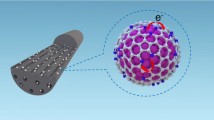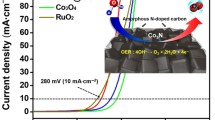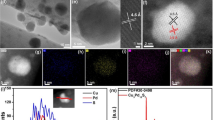Abstract
Catalytic materials without using precious metallic elements for electrocatalytic water splitting are a crucial demand to the renewable energy production. Cobalt molybdenum sulfide (CoMoSx) is one of the promising candidates for such purpose. Yet, the sparse catalytic active sites and poor electrical conductivity limit its catalytic performance. Here, we presented an efficient strategy to synthesize amorphous cobalt molybdenum supported on tree-dimensional network N-doped carbon nanofibers (CoMoSx/NCNFs) with the enlarged surface area. The obtained catalysts were characterized by scanning electron microscope (SEM), Transmission electron microscopy (TEM), powder X-ray diffraction (XRD), X-ray photoelectron spectrometer (XPS) and energy-dispersive X-ray spectroscopy (EDS) methods, and the catalytic activity was evaluated by electrochemical technique. In contrast to large aggregate CoMoSx particles grown on carbon paper electrode without NCNFs, CoMoSx/NCNFs/CP hybrid materials possess porous structure with an abundance of exposed active sites stacked onto NCNF surface. Benefiting from the synergistic effect between the amorphous CoMoSx and the underlying NCNF network, CoMoSx/NCNFs hybrid exhibits an excellent activity for hydrogen evolution reaction (HER) with a low onset overpotential of 117 mV, a Tafel slope of 75 mV/decade, and good stability.
Graphic Abstract






Similar content being viewed by others
References
Turner JA (2004) Science 305:972–974
Bartak DE, Kazee B, Shimazu K et al (1986) Anal Chem 58:2756–2761
Ge X, Chen L, Kang J et al (2013) Adv Funct Mater 23:4156–4162
Ge X, Chen L, Zhang L et al (2014) Adv Mater 26:3100–3104
Du H, Kong RM, Guo X et al (2018) Nanoscale 10:21617–21624
Kibsgaard J, Chen Z, Reinecke BN et al (2012) Nat Mater 11:963–969
Berit H, Poul Georg M, Jacob B et al (2005) J Am Chem Soc 127:5308–5309
Jaramillo TF, Jacob B, Nielsen JH et al (2007) Science 317:100–102
Chang K, Hai X, Pang H et al (2016) Adv Mater 28:10033–10041
Lukowski MA, Daniel AS, Meng F et al (2013) J Am Chem Soc 135:10274–10277
Zhang N, Ma W, Jia F et al (2016) Int J Hydrog Energy 41:3811–3819
Wang H, Tsai C, Kong D et al (2015) Nano Res 8:566–575
Lv X-J, She G-W, Zhou S-X et al (2013) Rsc Adv 3:21231–21236
Dominguez N, Torres B, Barrera LA et al (2018) ACS Omega 3:10243–10249
Merki D, Vrubel H, Rovelli L et al (2012) Chem Sci 3:2515–2525
Pham K-C, Chang Y-H, McPhail DS et al (2016) ACS Appl Mater Inter 8:5961–5971
Li Y, Wang H, Xie L et al (2011) J Am Chem Soc 133:7296–7299
Liao L, Zhu J, Bian X et al (2013) Adv Funct Mater 23:5326–5333
Wang J, Xu F, Jin H et al (2017) Adv Mater 29:1605838
Li DJ, Maiti UN, Lim J et al (2014) Nano Lett 14:1228–1233
Ekspong J, Sharifi T, Shchukarev A et al (2016) Adv Funct Mater 26:6766–6776
Zhao Y, Nakamura R, Kamiya K et al (2013) Nat Commun 4:2390
Tang YJ, Wang Y, Wang XL et al (2016) Adv Energy Mater 6:1600116
Yu P, Wang L, Xie Y et al (2018) Small 14:1801717
Wang Z-L, Hao X-F, Jiang Z et al (2015) J Am Chem Soc 137:15070–15073
Maitra U, Gupta U, De M et al (2013) Angew Chem Int Ed 52:13057–13061
He Y, Du S, Li H et al (2016) J Solid State Electr 20:1459–1467
Haq AU, Lim J, Yun JM et al (2013) Small 9:3829–3833
Wang J, Luo Q, Luo C et al (2017) J Solid State Electr 21:2071–2077
Dorjgotov A, Ok J, Jeon Y et al (2013) J Solid State Electr 17:2567–2577
Qiu Y, Yu J, Wu W et al (2012) J Solid State Electr 17:565–573
Gao S, Fan B, Feng R et al (2017) Nano Energy 40:462–470
Guruprasad K, Maiyalagan T, Shanmugam S (2019) ACS Appl Energy Mater 2:6184–6194
Dai X, Du K, Li Z et al (2015) ACS Appl Mater Interfaces 7:27242–27253
Liu X, Jiang J, Ai L (2015) J Mater Chem A 3:9707–9713
Feng J-X, Ding L-X, Ye S-H et al (2015) Adv Mater 27:7051–7057
Chen Y-W, Lin S-Y, Chiang C-Y (2017) Langmuir 33:4638–4646
Ye Z, Yang J, Li B et al (2017) Small 13:1700111
Laurenti D, Phung-Ngoc B, Roukoss C et al (2013) J Catal 297:165–175
Lai F, Miao Y-E, Huang Y et al (2015) ACS Appl Mater Interfaces 8:3558–3566
Weber T, Muijsers JC, Niemantsverdriet JW (1995) J Phys Chem 99:9194–9200
Pentland N, Bockris JM, Sheldon E (1957) J Electrochem Soc 104:182–194
Sheng W, Gasteiger HA, Shao-Horn Y (2010) J Electrochem Soc 157:B1529–B1536
Chen Y, Wang J, Liu H et al (2009) Electrochem Commun 11:2071–2076
Groves MN, Malardier-Jugroot C, Jugroot M (2012) J Phys Chem C 116:10548–10556
An W, Turner CH (2009) J Phys Chem C 113:7069–7078
Acknowledgements
This work was supported by the National Natural Science Foundation of China (21403174).
Author information
Authors and Affiliations
Corresponding author
Ethics declarations
Conflict of interest
The authors declare that there is no conflict of interest for each contributing author.
Additional information
Publisher's Note
Springer Nature remains neutral with regard to jurisdictional claims in published maps and institutional affiliations.
Electronic supplementary material
Below is the link to the electronic supplementary material.
Rights and permissions
About this article
Cite this article
Wang, S., Ge, X., Xiao, J. et al. Amorphous CoMoSx/N-Doped Carbon Hybrid with 3D Networks as Electrocatalysts for Hydrogen Evolution. Catal Lett 151, 1720–1727 (2021). https://doi.org/10.1007/s10562-020-03428-0
Received:
Accepted:
Published:
Issue Date:
DOI: https://doi.org/10.1007/s10562-020-03428-0




